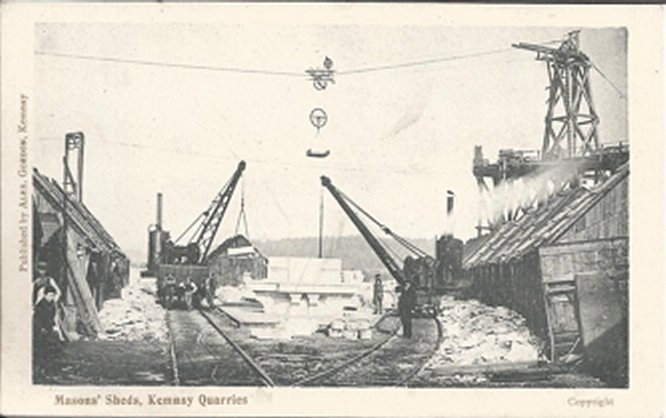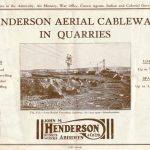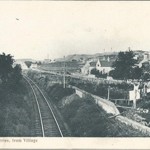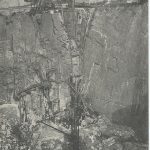Kemnay Quarry at Paradise Hill
Courtesy of The Doric Columns
Kemnay Quarries, were from 1858 leased by John Fyfe, an Aberdonian; by 1880, 250 men employed with 7 steam cranes and 2 Blondins (wire lifts – claimed as his invention). Blocks 30ft long and 100 tonnes in weight were produced in its heyday. Celebrated for supplying granite for the Holborn Viaduct. It was opened in 1830 by John Fyfe, and became fully commercial in 1858.
Kemnay Granite has been used in many famous buildings and structures, including:-
The London Cenotaph
Various buildings on Princes Street, Edinburgh
The Forth Railway Bridge
The Thames Embankment. Marischal College, Aberdeen
The Scottish Parliament, Edinburgh
Granite workers from Kemnay helped to quarry and shape the Australian granite used in the Sydney Harbour Bridge. They also travelled to Quarries in California, the Mississippi Levees and Odessa.

The above photograph shows a general view of surface working in grey muscovite-biotite granite. Shows pit-like form of quarry 122 m. deep. On the left of the photograph can be seen the sett-maker’s yard with the ‘scathies’ or huts set out at regular intervals, behind is the crushing plant. The various steel lattice towers are for the Blondins while below the crane on the pit edge are the ‘hutches’ for lowering the quarrymen to the bottom. The Blondin mast on the built-up platform just right of centre was called the ‘spion kop’ after a battle in Natal during the Boer War.

More than 100,000 tonnes of overburden and granite from the Kemnay Quarry near Aberdeen has been sculpted into a 25m high cairn to celebrate the Quarry’s History and the importance of Granite to Scotland. Kemnay granite has been used on Tower Bridge, the Forth Rail bridge and the new Scottish Parliament in Edinburgh. Three sculptors, John Maine, Brad Goldberg and Glen Unwin, worked with quarry owner Aggregate Industries to create the Place of Origin attraction that will allow visitors to gaze safely into the depths of the quarry. Most of the mound is overburden faced with 2 to 4 Ton granite blocks. Leading to the summit and dotted through a new woodland are a series of special feature areas with granite in its various forms, from glacial boulders to gravels and quarried blocks.
Kemnay Quarries, C1939 Surface working. A pit-like form of quarry 122 m. deep while above on the skyline was a large waste tip. A light railway network was present with several bogies used for transporting stone. Adjacent to the railway is a stockpile of kerbs and setts (cassies). A large crane is seen on the edge of the pit while a dismantled crane is employed near the Railway. Right through the centre was a ‘Blondin’ lifting cable. Several ‘Blondin’ cables are present, one with a pulley with a load going across. In front, near the crane are the ‘hutches’ the means by which the quarrymen were lowered to the quarry floor. John Fyfe of Kenmay Quarry is claimed to have invented ‘Blondins’ (see J M Henderson Patentee) and first used them in 1873. They were named after the famous French tight-rope walker Charles Blondin (real name Jean Francois Gravelet) (1824-97). Kemnay granite quarry in Aberdeenshire in 1939, a Railway which crosses a bridge over an access road. A ‘Blondin’ lifting cable is also seen.
The Alford Valley Railway (AVR), was constructed to enable the exploitation of the pink and grey granite quarries at Kemnay and Tillyfourie and also the famous Aberdeen Angus black cattle breeding and agricultural output from a large part of Aberdeenshire. The quarries really excelled with huge tonnages leaving on the line. Few realise that the Thames Embankments and Tower Bridge in London are built from Tillyfourie Granite, as a display of huge blocks testifies outside the Science Museum. The AVR is responsible for the present location of the village of Alford which grew around the new Terminus from 1859. It is the very reason Alford is here at all! The museum is pleased to be telling the full story and showing some of the surviving objects and pictures of the line?s heyday and final years.
Grampian Transport Museum, Alford. AB33 8AE.
Pitfodels House is situated on what was formerly part of the Estate of Pitfodels, owned from the 16th to the 19th century by the Menzies family. The last Laird of Pitfodels, John Menzies, died in 1805, after which his estate was feued off in lots. The Viewbank House that appears on the 1867 map probably dates from that period, so may have had an origin in the 1st half of the 19th century. Viewbank was subsequently purchased by James Collie, Advocate in Aberdeen and partner in the firm of James and George Collie. It is most likely that Collie ordered the demolition of the older Viewbank and employed Pirie and Clyne to erect the new one in 1881, which was later re-named Pitfodels House. 1914 ? 1948 owned by John Malcolm Fyfe, son of John Fyfe the founder of a large local granite quarry works. The business started at Tyrebagger and took over Kemnay Quarries in 1858. His son, who occupied Pitfodels House during World War II would have had easy access to good quality granite and it is possible that the granite did not come from the original Viewbank house but came from a Fyfe owned Quarry. (Set into the landscaped slope in front of Pitfodels House is a substantial bunker or shelter, constructed of concrete and granite, presumably during the 2nd World War. The bunker is 8.82M along the south-facing frontage and 9.34M along its N-S axis. The south wall is 0.42M thick and faced with granite blocks. Fyfe died in 1947-8 and the land was disposed to Aberdeen City Council in 1948 and transferred to Aberdeen International School in 2008.
The village of Kemnay is surrounded by trees, and has a picturesque situation on the right bank of the Don. Down to 1858 it was considered “a paltry hamlet,” but the construction of the Alford Valley Railway and the opening of extensive quarries in the near vicinity brought it fresh and solid prosperity. It is now considered to be one of the finest and most prosperous villages in the county. The old buildings have been swept away and replaced by substantial, prettily-designed cottages and villas, arranged according to a carefully prepared feuing plan.
Kemnay Quarry Tragedy – (Aberdeen Press and Journal, Saturday, August 3 1929)
Two quarrymen were swept over a 250ft high ledge by a fall of rock at the Kemnay Quarry. One was killed and the other had a miraculous escape. The man who lost his life was William Tough, aged about 30 years, who lived at Dalmadilly, Kemnay. His more fortunate worker was Andrew Robb, Kemnay Village. A squad of 12 men were engaged in clearing a ledge on the face of the Quarry at which blasting operations had been carried out during the day. This work consists of moving away the loose stones and sand and shovelling them over the side of the ledge, and the work can only be done when there is no one working down in quarry floor. The gang had been at work for some time on the ledge, which is fully half way up the 450ft face of the quarry, when, without the slightest warning, part of the slightly sloping wall behind them collapsed.
A small avalanche of boulders and loose smaller rocks swept down on to the ledge and Tough and Robb, who happened to be in the path of the rock-slide, were carried over the ledge. Both men, as did the rest of the squad, wore the safety ropes that the dangerous nature of their work demanded, but the weight and impact of the rocks which carried Tough over the side snapped his rope, and he hurtled down about 250ft to his death. Robb’s escape was miraculous. The debris which carried him over the edge fell clear of him and his rope held. He dropped about 30ft, and despite the fact that sand and gravel rained heavily upon him, he managed to find a foothold on the face of the quarry. He was hauled up to safety by his fellow workmen on the ledge, 2 of whom, Peter Mitchell and Andrew Lamond, both of Kemnay Village, had been slightly injured by the fall. When the workmen reached the foot of the quarry they found Tough’s body lying badly mangled among the rocks and stones which had caused his death. The body was removed to Kemnay, and the injuries of the other men were attended to. Robb escaped severe injury, but complained of pains in his back. The deceased man, who leaves a widow and 1 child, was an experienced quarryman, and had been employed at Kemnay Quarry for some time.
Further Reference
John Fyfe
John Gilmore
Burnetts of Kemnay
Kemnay Railway
Kirkstyle
Acknowledgements and Sources of Information
Doric Columns
Ian Carter, Senior Lecturer in Sociology at Aberdeen University
Evening Express on 05 July 1980,














